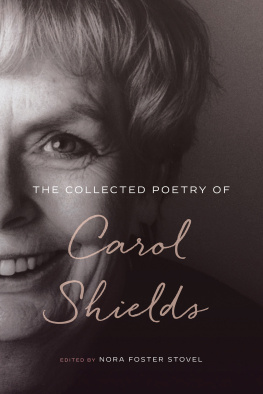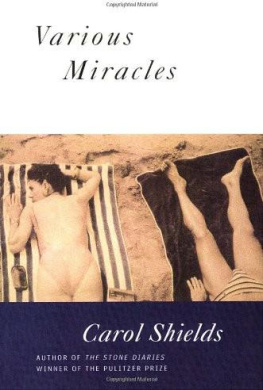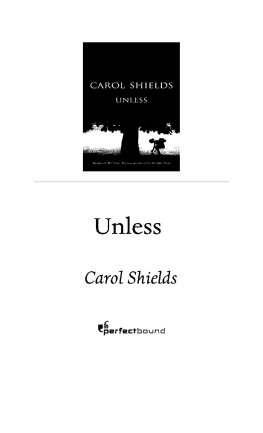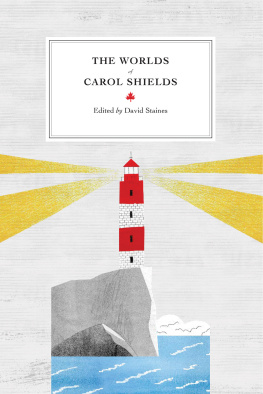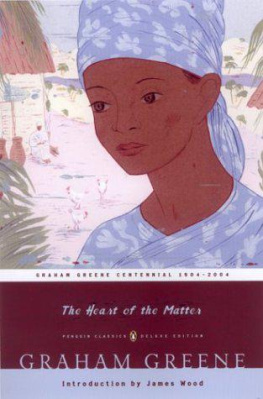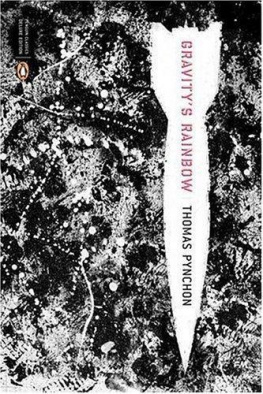The Stone Diaries
Carol Shields
SUMMARY:
The Stone Diaries is the story of one woman's life; a truly sensuous novel that reflects and illuminates the unsettled decades of our century. Born in 1905, Daisy Goodwill drifts through the chapters of childhood, marriage, widowhood, remarriage, motherhood and old age. Bewildered by her inability to understand her own role, Daisy attempts to find a way to tell her own story within a novel that is itself about the limitations of autobiography.
carol shields The Stone Diaries Introduction by penelope lively
carol shields (19352000) is the author of Dressing Up for the Carnival; Larrys Party, which won the Orange Prize; and The Stone Diaries, which won the 1995 Pulitzer Prize for Fiction and the National Book Critics Circle Award. Her other novels and short story collections include The Republic of Love, Happenstance, Swann, The Orange Fish, Various Miracles, The Box Garden, and Small Ceremonies .
penelope lively is the author of numerous award-winning novels, including The Photograph, Consequences, and the Booker Prizewinning Moon Tiger . She lives in London.
PENGUIN BOOKS Published by the Penguin Group Penguin Group (USA) Inc., 375 Hudson Street, New York, New York 10014, U.S.A.
Penguin Group (Canada), 90 Eglinton Avenue East, Suite 700, Toronto, Ontario, Canada M4P 2Y3 (a division of Pearson Penguin Canada Inc.)
Penguin Books Ltd, 80 Strand, London WC2R 0RL, England Penguin Ireland, 25 St Stephens Green, Dublin 2, Ireland (a division of Penguin Books Ltd)
Penguin Group (Australia), 250 Camberwell Road, Camberwell, Victoria 3124, Australia (a division of Pearson Australia Group Pty Ltd)
Penguin Books India Pvt Ltd, 11 Community Centre, Panchsheel Park, New Delhi110 017, India Penguin Group (NZ), 67 Apollo Drive, Rosedale, North Shore 0632, New Zealand (a division of Pearson New Zealand Ltd)
Penguin Books (South Africa) (Pty) Ltd, 24 Sturdee Avenue, Rosebank, Johannesburg 2196, South Africa Penguin Books Ltd, Registered Offices:
80 Strand, London WC2R 0RL, England First published in Great Britain by Fourth Estate Limited 1993
First published in the United States of America by Viking Penguin, a division of Penguin Books USA Inc. 1994
Published in Penguin Books 1995
This edition with an introduction by Penelope Lively published 2008
Copyright Carol Shields, 1993
Introduction copyright Penelope Lively, 2008
All rights reserved Publishers Note This is a work of fiction. Names, characters, places, and incidents either are the product of the authors imagination or are used fictitiously, and any resemblance to actual persons, living or dead, business establishments, events, or locales is entirely coincidental.
LIBRARY OF CONGRESS CATALOGING IN PUBLICATION DATA Shields, Carol.
The stone diaries Carol Shields ; introduction by Penelope Lively.
p. cm.(Penguin classics deluxe edition)
ISBN: 1-4295-6172-6
1. WomenFiction. I. Title.
PR9199.3.S514S76 2008
813'.54dc22
2008028398
Set in Filosofia
For my sister, Babs
A number of people have read the manuscript for this book and offered encouragement and suggestions. I thank Blanche Howard, Joan Clark, Jim Keller, Anne Giardini, Catherine, Meg and Sara Shields, and, especially, Miss Louise Wyatt of London, Ontario.
Nothing she did or said was quite what she meant but still her life could be called a monument shaped in a slant of available light and set to the movement of possible music (From "The Grandmother Cycle" by Judith Downing, Converse Quarterly , Autumn)
INTRODUCTION
The best fiction surprisesand withholds. Each time that I read The Stone Diaries I see it differently. It is a story, first of allthe story of a woman, Daisy Goodwill, later Daisy Goodwill Flett. It is also many storiesthose of her family and her friends. You read it first as such, drawn in at once by the compelling opening pages, and then keen to know what is going to happento Daisy, to the rest of them. Subsequently it becomes a view of how one womanmany womenlived in the twentieth century, what they expected and what was expected of them. It can be seen as a discussion of the nature of evidencethe way in which there is no single truth about anyones life, but as many truths as there are observers.
And if you are interested in how a novel is made, it turns into an exercise in narrative technique. And, perhaps, airilya demonstration of how a novelist can successfully juggle a cast of twenty characters and more over time and space without bewildering the reader.
Here is a story that opens in Manitoba in 1905 and ends in Florida in the 1990s. From birth to deaththe parabola of a life, a North American life, with brief excursions to France, to Orkney. Daisy is born into a world that has known neither of the world wars, and in which a woman is required to be first and foremost a domestic support system. She leaves another one in which the globe has contracted and women expect to work outside the home. Her father-in-law sails the Atlantic as a young immigrant from Orkney: At the end of the century Daisy will fly the ocean to trace him. She has experienced the century in a temporal sense, but, as we learn in one of the novels deft commentaries, she has never known nude bathing, pierced ears, body massage, and much else that could be seen to characterize the age. Born in "the murderously hot back kitchen" of a Manitoba stone-workers home, she will spend her last years in a three-bedroom Florida condo, a Florida bluehead in a turquoise pantsuit.
Kitchens are rich with significance in the novelkitchens and what is done in them. The vivid opening chapter has the kitchen as the scene of both birth and death, with the Malvern pudding that Daisys mother, Mercy, is cooking as an emblem of domestic labor and achievementthe thickly cut bread, the oozing fruit juices, the sugar. Many years later, Daisy prepares supper for her familyhusband, three childrenin an Ottawa kitchen (summer heat once more, so a cold meal): jellied veal loaf, sliced tomatoes, potato salad, raspberries again, but in little glass bowls. There is care and attention: the formality of a tablecloth, and before her husbands return from work Daisy "fixes" herselfhousedress off, fresh clothes, earrings, lipstick. We are told that Daisy desiresdeeply, fervently, sincerelyto be a good wife and mother. She is an assiduous reader of womens magazines, in support of this ambition. In one of the novels many significant asideshow others see Daisywe are given the possible contrasting reactions of a visiting friend of her girlhood, Fraidy Hoyt, herself unmarried and childless. She is perhaps grimly enviousof the distinguished husband, the big house, the beautiful children; or, is she pityingly contemptuous of this woman drowning in domesticity, child-ridden, who probably hasnt read a book in ten years?
Teasingly, we are not told which view Fraidy holds, but this is 1947, and it is tempting to see Fraidy as the voice of the future, ahead of her day, already with the assumptions of the postfeminist woman.
Throughout the novel, the authorial voice alternates with those other voices, creating a deliberate ambiguity. We know what happens to Daisy, and frequently she speaks for herself, but we see her also as others see her, and no two people see her in the same way. Was she happy as a domestic goddess? Maybe not, for in the next, and crucial section of the booksignificantly called "Work, 19551964"she is shown, entirely obliquely, through a sequence of letters written by others, as immersed in a new role as Mrs. Green Thumb, gardening correspondent for the local paper, and eventually devastated and plunged into a lengthy episode of depression when she gets the sack. So was domestic life not work? This section is one of the most powerful in the novelclever and funnyand it gives much pause for thought, as we see Daisys life of that time shimmer behind the words of other people, and it becomes clear that this is the point at which Daisy has achieved some kind of fulfillment and discovers in herself a capacity of which she had been unaware. She strove to be a good wife and mother, but was she in fact stifled by that role?


